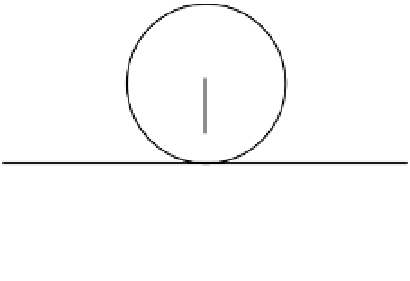Game Development Reference
In-Depth Information
As was done with the previous problem, the analysis of this problem begins with a force
diagram, shown in Figure 4-14. The bowling ball is sliding down the lane with a translational
velocity,
v
x
. The surface is horizontal, so the normal force,
F
N
, between the ball and the lane is
equal to the gravitational force,
mg
. A frictional force,
F
f
, resists the sliding motion and is equal
to the coefficient of friction,
m
, between the ball and the lane multiplied by the normal force.
Figure 4-14.
Force diagram of a sliding bowling ball
As with the object rolling down a ramp, the friction force acting on the outer surface of the
bowling ball creates a torque about the center of mass of the ball. According to Equation (4.30),
the torque results in an angular acceleration of the ball.
τ
==
Fr
μ
mgr
=
I
α
(4.41)
The torque applied to the ball causes it to rotate. The angular velocity,
w
, of the ball continues
to increase until the ball is rolling without sliding. When the ball is no longer sliding, there is no
sliding friction, and the friction force goes to zero. The point at which the ball rolls without
sliding is when the translational velocity,
v
x
, is equal to the angular velocity multiplied by the
radius of the bowling ball.
x
vrω
=
(4.42)
The key to solving the bowling ball problem is to determine when the condition shown in
Equation (4.42) occurs. Let's start by determining an equation for angular velocity as a function
of time. As the ball slides down the lane, the angular velocity,
w
, increases according to
Equation (4.41).
ωμ
α
==
d
gr
(4.43)
dt
I
An equation for
w
as a function of time can be found by integrating Equation (4.43).
μ
mgr
t
I
ω
=
+
ω
(4.44)
0












